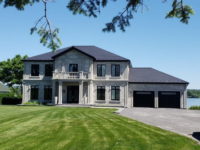Beating the Heat
The Best Roofs for Summer May Not Be Green
Latest research affirms that white roofs are most effective at cooling the city down on the hottest summer days

A roofing crew creates a cool roof in downtown Washington, D.C. A new study from University College London shows that “cool roofs” may have a larger heat-reducing impact in urban areas that lack sufficient greenspace.
— Photo by Maria Jose-Vinas, American Geophysical Union
Increasingly hot summer days throughout the country, particularly in urban areas with more pavement than greenspace, have city dwellers seeking relief; a recent study out of the University College London affirms the best bet might not be ‘green’ roofs but white ones.
The research has again challenged the conventional belief that green roofs integrated with vegetation can most effectively reduce outdoor temperatures by absorbing sunlight and evaporating water. As University College London researchers reported last Thursday, a simulation of London's two hottest days in summer 2018 revealed that these roofs had negligible cooling effects.
But cool roofs — those covered in white or reflective material — helped reduce temperatures by 1.2 degrees Celsius (2.2 degrees Fahrenheit) on average. “Statistically, a degree or two of difference can lead to a substantial number of lives being saved,” the report’s lead author, Oscar Brousse, a senior research fellow and lecturer at University College, said after its release, which was first reported by Bloomberg news.
London is one of several cities experimenting with different types of roofs to reduce the urban heat island effect, which causes densely populated areas to become hotter than the surrounding regions. Finding the right mix of roofing options could have numerous benefits for a city with relatively few adaptations for hot weather. According to one estimate, heat-related deaths in the region begin to increase at just 66.2 degrees Fahrenheit and rise by over 3% with every degree above 70.7 degrees Fahrenheit.
To conduct the study, the researchers ran 11 climate simulations to investigate the impact of 10 different urban heat reduction strategies on two days in July 2018 when the temperature reached 91.4 degrees Fahrenheit and 98.6 degrees Fahrenheit, respectively.
Green roofs were found to reduce temperatures by as much as 33.4 degrees Fahrenheit during the hottest hours of the day. Yet, researchers found that even if implemented citywide, their impact was negligible, on average, over the course of the entire day. On the other hand, cool roofs had a more robust effect — two to two-and-a-half times greater — during the hottest hours of the day.
While the new research is informative, it comes with some caveats. Modeling can offer broad insights, but scientists admit that more research is necessary to understand the cooling impact of green roofs in the real world on days similar to those studied.
To read the full study, click HERE.
Looking for a reprint of this article?
From high-res PDFs to custom plaques, order your copy today!







